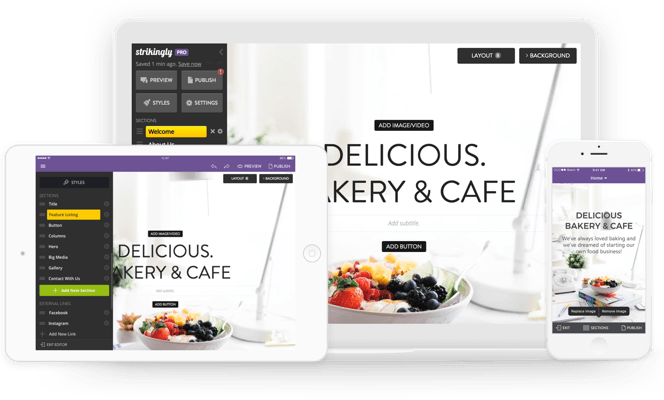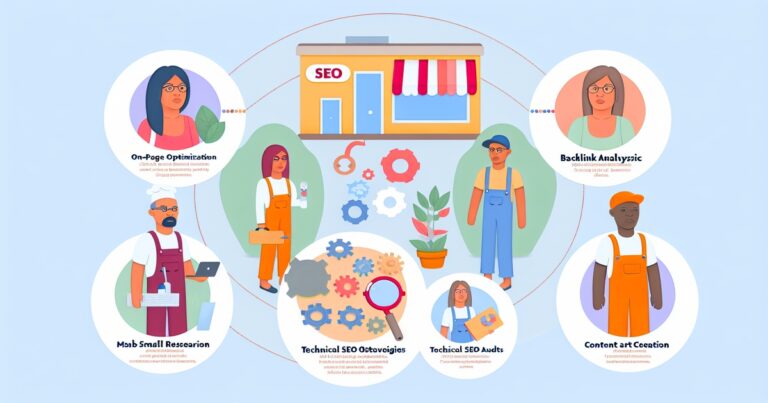In today’s digital age, having a website for your local business is not just an option, but a necessity. With the majority of consumers using the internet to search for products and services, businesses without a web presence are at a significant disadvantage.
Having a website can help you reach new customers, improve customer engagement and communication, and establish your business as a credible industry leader. In this article, we will explore the importance of having a website for local businesses and how to use it to grow your business.
The Importance of Having A Website For Local Businesses
A website is an essential tool for any local business that wants to stay relevant in today’s marketplace. Not only does it provide potential customers with easy access to your products or services from anywhere at any time, but it also allows you to market yourself more effectively.
Without a website, you are missing out on valuable opportunities to expand your audience and increase sales. With consumers increasingly turning to online channels for their purchasing decisions, having an online presence has become non-negotiable.
Furthermore, having an up-to-date website also improves your credibility as a business. A poorly designed or outdated site can have the opposite effect and turn potential customers away before they even give you the chance to impress them with what you offer.
Purpose of The Article
The purpose of this article is simple: To help local businesses understand why having a website is crucial in today’s world. More importantly, we want to highlight how they can use their website as an effective tool for growth.
We will be discussing various strategies that businesses can use on their websites such as search engine optimization (SEO), e-commerce integration, online reviews and reputation management among others so that they can maximize the potential benefits they get from these tools. By the end of this article, we hope that our readers will have gained some insight into the many ways they can leverage their website to grow their business, reach new customers and establish themselves as credible industry leaders.
High-Level Overview of Website Benefits for Local Businesses
As a local business owner, you may already know the importance of establishing a strong presence in your community. But with more consumers turning to the internet to research products and services before making a purchase, having a website has become just as crucial as having a physical storefront. In this section, we will explore how having a website can benefit your local business in three key areas: increased visibility and accessibility, improved customer engagement and communication, and enhanced credibility and trustworthiness.
Increased Visibility and Accessibility
One of the primary advantages of having a website is that it allows your business to be visible to potential customers beyond your immediate geographic area. With the use of search engine optimization (SEO) techniques such as keyword research, meta tags, and backlinks, you can improve your website’s ranking on search engine results pages (SERPs). This means that when someone searches for keywords related to your business or industry in their area, they are more likely to find your website among the top results.
In addition to improving visibility, having a website also increases accessibility for customers who prefer online shopping or browsing. By providing detailed product or service information on your site along with clear calls-to-action (CTAs), you can encourage visitors to make purchases or contact you directly through your site.
Improved Customer Engagement and Communication
Engaging with potential customers through digital channels has become increasingly important for businesses of all sizes. A well-designed website can provide several opportunities for customer engagement including social media integration, chatbots or online customer service chat options. Through these channels customers are able interact with brands faster than traditional methods like phone or email which leads to improved satisfaction rates.
Additionally websites offer more ways than ever before for businesses to communicate directly with their audience. By incorporating web forms into relevant areas on your site such as contact pages or service request pages, customers can quickly and easily request information or schedule appointments.
Enhanced Credibility and Trustworthiness
For local businesses, establishing a reputation of trust and credibility within the community is crucial. A website can greatly enhance this aspect by offering a professional online presence along with detailed information on your background, experience, customer testimonials/reviews and awards won. This not only boosts customer confidence in your business but also helps attract new customers who are looking for trustworthy businesses to patronize.
Having a website is an essential part of any local business’s growth strategy. By increasing visibility and accessibility, improving customer engagement and communication, and enhancing credibility and trustworthiness, businesses can create a strong online presence that will drive growth both online and offline.
Search Engine Optimization (SEO)
The Importance of Local SEO
An effective local SEO strategy can help your local business to rank higher in search engine results pages (SERPs). This means that when someone searches for a product or service related to your business, they are more likely to find you.
It is crucial for small businesses to optimize their website content for local search because customers tend to search for businesses within their geographical vicinity. By implementing local SEO tactics, your business can increase its visibility and reach potential customers who are looking for what you have to offer.
Tips for Optimizing Website Content for Local Search
One of the best ways to improve your local SEO is by conducting keyword research. This involves finding relevant and frequently searched phrases that people use when looking for products or services like yours.
Once you have identified these keywords, you should incorporate them naturally into your website content, including page titles, headers, meta descriptions, and body copy. Another crucial factor in local SEO is claiming and optimizing your Google My Business listing.
This free tool allows you to manage how your business appears on Google Maps and in search results pages. By filling out all relevant information on this listing such as address, phone number, hours of operation and customer reviews; it will make it easier for potential customers to find and connect with you.
Online Reviews and Reputation Management
The Impact of Online Reviews on Consumer Behavior
Research has shown that online reviews play a significant role in the decision-making process of consumers today. Positive reviews can increase consumer trust in a brand while negative reviews can discourage people from doing business with a company altogether. As such it’s critical that businesses actively monitor their online reputation by regularly checking popular review sites such as Yelp or Google My Business.
Strategies for Managing Online Reputation through Your Website
One way to manage your online reputation is by including customer reviews on your website. This can be done through a dedicated review page or by embedding reviews from third-party sites onto relevant pages.
Responding to both negative and positive reviews is also important as it shows that you care about your customers’ experiences and are willing to address issues publicly. In addition, businesses should build a strong social media presence, respond promptly to customer inquiries and be transparent when things go wrong instead of hiding behind ambiguous company policies.
E-commerce Integration
Benefits of Selling Products/Services Online
There are numerous benefits for small businesses in selling their products/services online: increased product visibility, the ability to reach a wider market, 24/7 accessibility to customers, reduced overhead costs and higher profit margins compared with brick-and-mortar stores.
How to Integrate E-commerce into Your Website
Integrating e-commerce functionality into your website isn’t as difficult or expensive as you may think. There are many affordable e-commerce platforms such as WooCommerce or Shopify that can integrate seamlessly into your existing website design. You will need high-quality product photography, well-written descriptions, payment processing integrations among others depending on the industry you operate in.
To successfully use e-commerce integration for growth, businesses should focus on providing excellent customer service by ensuring rapid shipping times and making returns simple – all while emphasising personal touches such as handwritten thank-you notes with every order. Additionally, personalised recommendations based on past purchases could foster trust-building relationships with customers encouraging them for repeat purchases
Rarely Known Small Details: Additional Ways to Utilize Your Website for Growth
Blogging and Content Marketing
The Benefits of Blogging for Local Businesses
Blogging is a highly effective way for local businesses to connect with their audience, attract new customers, and establish themselves as industry thought leaders. By creating valuable content that addresses the questions and concerns of your target market, you can position yourself as a trusted authority in your field.
Blogging also provides an opportunity to improve your website’s search engine rankings through the use of targeted keywords and phrases related to your business. Search engines reward websites that provide fresh, high-quality content on a regular basis.
In addition, blogging allows local businesses to showcase their unique brand personality and engage with customers on a more personal level. By sharing behind-the-scenes stories, product updates, and industry news, you can build stronger relationships with your audience and foster greater customer loyalty.
Tips for Creating Engaging Blog Content that Drives Traffic to Your Website
To create blog content that resonates with your target market and drives traffic to your website, it’s important to first understand what topics are most relevant and helpful for them. Consider conducting surveys or social media polls to gather feedback from your audience on the types of content they want to see.
When creating blog posts, focus on providing value by addressing common pain points or challenges that your customers face. Use clear language and break up text with subheadings, bullet points, or images to make the content easier to read.
Promote each new blog post through social media channels or email newsletters to maximize its visibility. Encourage readers to share the post with their own networks or leave comments on the post itself.
Lead Generation Strategies
Using Landing Pages To Capture Leads From Website Visitors
Landing pages are standalone web pages designed specifically to capture leads or conversions from website visitors. By directing traffic to a landing page with a clear call-to-action, such as filling out a form or downloading an e-book, businesses can increase their chances of converting casual visitors into leads.
To create an effective landing page, it’s important to keep the design simple and uncluttered. Use contrasting colors for the call-to-action button and make sure the form is easy to fill out and submit.
In addition, consider offering something of value in exchange for contact information, such as a free trial or demo of your product/service. This will incentivize visitors to provide their information and increase the likelihood of conversion.
Creating Compelling Calls-To-Action (CTAs)
A strong call-to-action is essential for guiding website visitors towards taking action on your site. Whether it’s filling out a form, making a purchase, or signing up for a newsletter, CTAs should be prominently displayed on every page of your website. To create compelling CTAs that drive action, use action-oriented language that clearly conveys the benefit of taking action.
For example, “Sign up now for exclusive discounts” is more persuasive than simply saying “Sign up.” Additionally, use contrasting colors and bold fonts to make CTAs stand out from surrounding content.
Position them above-the-fold (the area of the page that is visible without scrolling) for maximum visibility. By focusing on these rarely known small details – blogging and content marketing strategies and lead generation techniques – local businesses can take full advantage of their website’s potential to drive growth.
Conclusion: The Power of a Well-Designed Website A well-designed website is an incredibly powerful tool that local businesses can leverage to grow their customer base, increase sales, and improve their overall online presence.
By utilizing the right strategies, such as optimizing for local search and integrating e-commerce functionality, businesses can take advantage of the many benefits that come with having a strong digital footprint. One major advantage of a well-designed website is increased visibility and accessibility.
With more and more consumers turning to the internet to find local businesses, having a website that ranks well in search engine results pages (SERPs) is essential. By implementing best practices for local SEO, such as including location-specific keywords in content and meta tags, businesses can ensure they show up prominently in relevant search queries.
Additionally, by making it easy for customers to find information about products or services on their websites, businesses can improve accessibility and make it easier for people to make informed decisions about where to shop. Another key benefit of a well-designed website is improved customer engagement and communication.
With features like live chat support or online booking systems integrated into their website design, businesses can provide better customer service while also building trust and establishing credibility with potential customers. Plus, by leveraging social media integration tools like Facebook or Twitter feeds on their site pages or blog posts featuring helpful tips or tutorials related to their products/services offering valuable insights beyond what’s offered at physical locations.
There’s no denying the power that a well-designed website has when it comes to helping local businesses grow. By following best practices for SEO optimization and integrating e-comm









